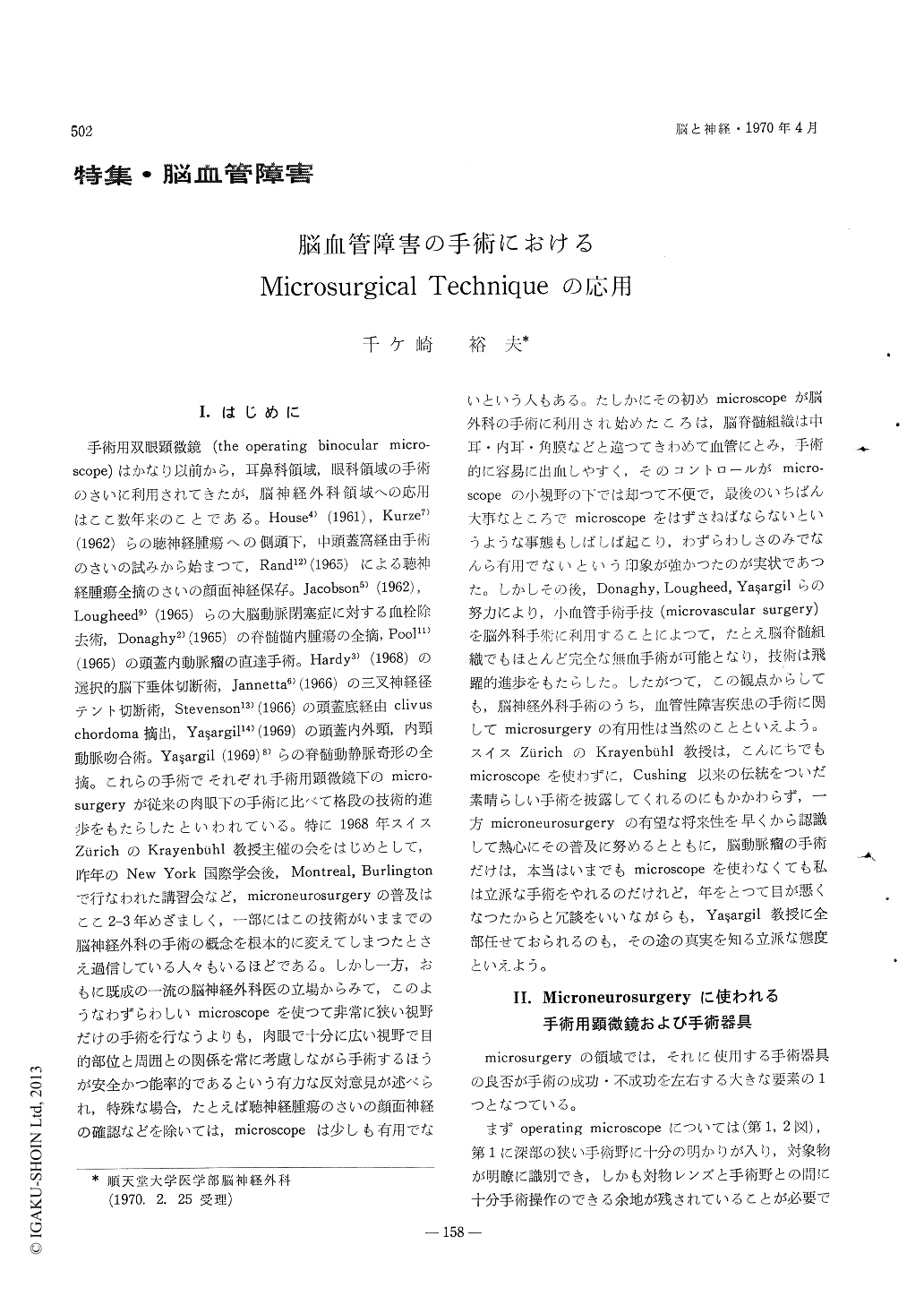Japanese
English
- 有料閲覧
- Abstract 文献概要
- 1ページ目 Look Inside
I.はじめに
手術用双眼顕微鏡(theoperating binocular micro—scope)はかなり以前から,耳鼻科領域,眼科領域の手術のさいに利用されてきたが,脳神経外科領域への応用はここ数年来のことである。House4)(1961).Kurze7)(1962)らの聴神経腫瘍への側頭下,中頭蓋窩経由手術のさいの試みから始まつて,Randi12)(1965)による聴神経腫瘍全摘のさいの顔面神経保存。Jacobson5)(1962),Lougheed9)(1965)らの大脳動脈閉塞症に対する血栓除去術,Donghy2)(1965)の脊髄髄内腫瘍の全摘,Pool11)(1965)の頭蓋内動脈瘤の直達手術。Hardy3)(1968)の選択的脳下垂体切断術,Jannetta6)(1966)の三叉神経径テント切断術,Stevensoni13)(1966)の頭0蓋底経由clivuschordoma摘出, Yaşargil14 (1969)の頭蓋内外頸・内頸動脈吻合術。Yaşargil (1969)8)らの脊髄動静脈奇形の全摘。これらの手術でそれぞれ手術用顕微鏡下のmicro—surgeryが従来の肉眼下の手術に比べて格段の技術的進歩をもたらしたといわれている。特に1968年スイスZürichのKrayenbühl教授主催の会をはじめとして,咋年のNew York国際学会後, Montreal,Burlingtonで行なわれた講習会など,microneurosurgeryの普及はここ2-3年めざましく,一部にはこの技術がいままでの脳神経外科の手術の概念を根本的に変えてしまつたとさえ過信している人々もいるほどである。しかし一方,おもに既成の一流の脳神経外科医の立場からみて,このようなわずらわしいmicroscopeを使つて非常に狭い視野だけの手術を行なうよりも,肉眼で十分に広い視野で目的部位と周囲との関係を常に考慮しながら手術するほうが安全かつ能率的であるという有力な反対意見が述べられ,特殊な場合,たとえば聴神経腫瘍のさいの顔面神経の確認などを除いては,microscopeは少しも有用でないという人もある。たしかにその初めmicroscopeが脳外科の手術に利用され始めたころは,脳脊髄組織は中耳・内耳・角膜などと進つてきわめて血管にとみ,手術的に容易に出血しやすく,そのコントロールがmicro.scopeの小視野の下では却つて不便で,最後のいちばん大事なところでmicroscopeをはずさねばならないというような事態もしばしば起こり,わずらわしさのみでなんら有用でないという印象が強かったのが実状であつた。しかしその後,Donaghy,Lougheed,Yaşargilらの努力により,小血管手術手技(microvascular surgery)を脳外科手術に利用することによつて,たとえ脳脊髄組織でもほとんど完金な無血手術が可能となり,技術は飛躍的進歩をもたらした。したがつて,この観点からしても,脳神経外科手術のうち,血管性障害疾患の手術に関してmicrosurgeryの有用性は当然のことといえよう・スイスZürichのKrayenbühl教授は,こんにちでもmicroscopeを使わずに,Cushing以来の伝統をついだ素晴らしい手術を披露してくれるのにもかかわらず,一方microneurosurgeryの有望な将来性を早くから認識して熱心にその普及に努めるとともに,脳動脈瘤の手術だけは,本当はいまでもmicroscopeを使わなくても私は立派な手術をやれるのだけれど,年をとつて目が悪くなつたからと冗談をいいながらも,Yaşargil教授に全部任せておられるのも,その途の真実を知る立派な態度といえよう。
Although the operating binocular microscope has been used for fairly long time in the otolaryngology and ophthalmology, it is only for the last several years that the microsurgical technique with the operating microscope is introduced into the neurosur-gical operations. Quite different from the oto-, oph-thalmological organs, the brain and the spinal cord are highly vascularized and very difficult in controll-ing the bleeding during the operation and this fact gives much disadvantages and often makes it im-possible to continue the operation under the micro-scope. Therefore, the introduction of microvascular technique into the neurosurgical operations byDonaghy and Yasargil has brought remarkable technical progress and improvement in the micro-neurosurgery.
The operating microscope for neurosurgical opera-tions needs specially free mobility during the opera-tive procedure and good illumination in the deep field. In the microneurosurgery, delicate microsurgi-cal insruments, specially a good bipolar coagulator unit with miniatured forceps are indispensable as well as the operating microscope.
In the neurosurgical operations, intracranial vas-cular surgery is the most useful and fruitful indica-tion of application of microsurgical and microvascular technique. Although still needed for surgeon's skill-fulness and experience, dissection (sharp dissection) around the aneurysmal neck and clipping, ligation or resection of the aneurysm, preserving the sur-rounding normal brain tissue and vessels which procedure is thought to be essential for the post-operative good prognosis are much more easily done under the microscope. The deep seated intracranialarterio-venous malformation can be totally extirpated more easily and steadily without any serious post-operative neulological deficit, if the lesion is carefully and bloodlessly dissected from the adjacent normal brain tissue under the microscope.
With progress of microvascular surgery, embolect-omy, endoarterectomy and anastomosis with other vessels in the cranial main vessels (0.51 mm in diameter) can be performed with success. However, technically successful, it has still many problems to solve about the clinical significance and indication of this kind of procedures.
Although with use of the microsurgical technique neurosurgeons are able to handle intracranial vas-cular lesions more finely, easily and steadily, they should know that microsurgery is only a kind of new tool for neurosurgical operations, which still needs their full knowledge and long experience about neurosurgery.

Copyright © 1970, Igaku-Shoin Ltd. All rights reserved.


